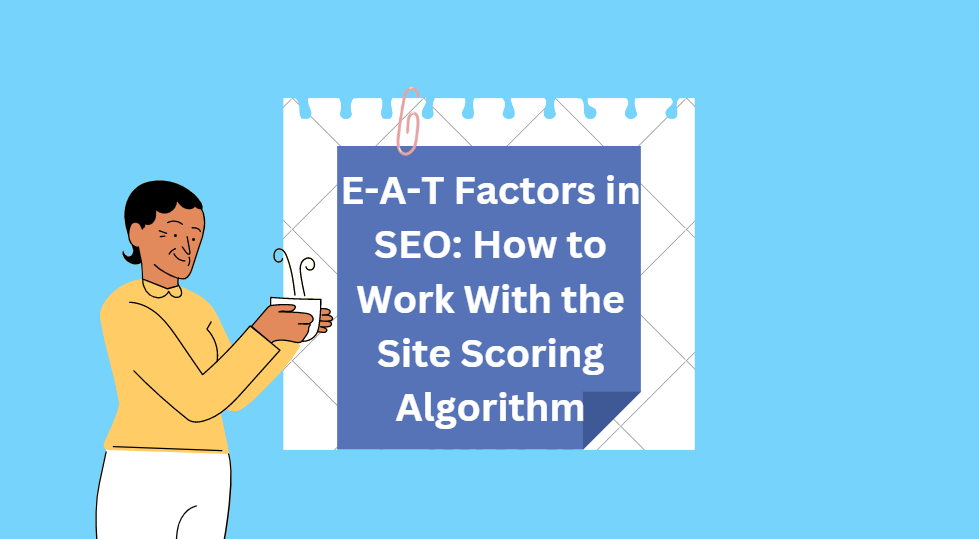As soon as Google began to apply E-A-T factors, many questions arose about how they work and how much they affect the promotion of sites in search. In this article, we will understand what E-A-T is, who evaluates sites according to these factors, and how it affects page rankings in Google.
What are Google E-A-T factors in SEO and how they affect rankings
E-A-T factors are a set of metrics that determine the quality of content on Google. The abbreviation E‑AT stands for expertise, authoritativeness, trustworthiness – expertise, authority and reliability. The term originated in the SEO community from Google’s guide to evaluating search quality. This is a 168 page document that is used by the Assessors. Assessors are Google employees who evaluate the quality of pages and entire resources on a number of parameters. Among these parameters are the E-A-T factors.
It is important to understand that E-A-T is not an algorithm, not a rating, it does not have any kind of quantitative assessment. The essence of E-A-T is that the content on the sites should be created by top SEO services in their field: a medical article by a doctor or an author with a medical education, advice in the field of jurisprudence by a lawyer.
Which Sites Must Consider E-A-T
E-A-T factors are taken into account for sites of any subject, but they do not have the same weight for all. In some topics, the source of information is simply ordinary people with life experience, while in others, expert opinion is needed.
In the Search Quality Guidelines, Google explicitly states that these parameters are especially important for YMYL – “Your Money or Your Life” sites that deal with finance, life and human health.
Google highlights the following YMYL-themed sites or pages:
pages on which any financial transactions take place (purchases or money transfers);
pages that can offer information on financial literacy;
pages containing medical information;
pages with legal information;
news and public/official information pages that describe local or global current events;
other pages – which convey important high-risk information, such as “adoption of children, information about car safety.”
Search engine requirements are moving towards useful content for users. If there is information on your site that is not confirmed by an expert, then it will simply stop ranking. Google doesn’t want to take risks. He wants people to use his search engine and get reliable information from there. That’s why it’s so important to incorporate E‑AT factors into your site.
In 2018, Google introduced an update called the Medic Update (medical), as it affected sites with medical topics the most. All projects that did not pay attention to the expertise of the content lost their positions.
Google now has a better understanding of the user’s intent, and it is important for them to provide verified information, so it is worth paying special attention to E-A-T factors.
An intent is a user’s intent or need that is reflected in a search query.
List of E-A-T factors and recommendations on how to improve websites
Before working on the factors, conduct a technical audit of the site. Surely you know all these points, but it will not be superfluous to remind them again:
- The site must have an SSL certificate or a redirect from HTTP to HTTPS. You can check it either in the Screaming Frog program or in the free redirect checker.
- No broken links. Ideally, your site should not have broken links. You can also check if they are or not using Screaming Frog.
- Site loading speed. This is where behavioral factors come into play. If your site takes a long time to load, then the user will simply not wait and close the tab. General speed recommendations: 50-60 for mobile devices and at least 80 points for computers by Page Speed Insights .
- Adaptive (mobile) version of the site. Now half of the traffic comes from mobile devices, which is why it is so important to have a mobile version of the site. If it is not there, then you will see the corresponding messages in Webmaster and Google Search Console. You can see traffic shares here .
- No duplicates. Your site should not have duplicate pages and metadata, otherwise the search engine will not be able to choose which page to show in the results.
- Server response speed. This refers to the server response time. You can check the speed using this server from Webmaster.
Now let’s take a closer look at the E-A-T factors and how to work with them to influence assessors’ scores.
Expertise
The essence of expertise is to show Google that the content on the site is created by experts in their field.
Now, when publishing articles, they must clearly identify the authors. The main thing is that it is clearly visible who the author of the content is, and there is information about the expertise of this author in the search engine. The more citations and publications, the better. The author’s social networks are also quoted, where he also publishes content on the topic.
For YMYL-themed sites, the presence of an author is a mandatory item. An article on property inheritance rules written by a lawyer in the subject is more credible and more likely to be reliable than an article by an unknown layman.
Create a page/card of the expert who is the author and be sure to place a link with the name under the articles. Place awards, certificates, achievements in the card. Describe in detail his qualifications. For example, on the website of the Efimed dental clinic, under an article about dentures, there is the signature of the author of the doctor. When you click on the doctor’s name, we go to his card, where we can see all the information about him.
Authority
Website authority refers to its reputation on the Internet. Google evaluates a number of parameters, and based on them calculates the authority of the resource:
- Reviews
Work on reviews. Audit reviews of your site on third-party resources. Reviews can be on aggregator sites of companies in your field, in social networks, and also in the search results in the Google My Business card.
Your brand’s online reputation carries a lot of weight as it directly affects the improvement of E-A-T.
If you find a negative review about your brand, services or products, then resolve this issue as soon as possible. Analyze why this happened and make changes so that such situations do not happen again.
- Link mass
Start building links from authoritative domains. Let there be few links, but they will be of high quality.
The authority of the site is determined by the Page Rank indicator, which is related to the number of links from authoritative resources. Evaluate the links of competitors and the type of anchors.
Analyze your entire link profile and remove the frankly purchased ones.
Social media mentions. Google evaluates the presence of the company in social networks, and mentions of well-known resources increase the authority of the site.
References in well-known sources. One such authoritative platform is Wikipedia. Getting a separate Wikipedia page about your company is very difficult, but you can try to edit any article, adding important information and leaving links to the source, that is, to your site.
Trustworthiness
After working on the factors of expertise and authority, start working on the credibility of the site and content. You need to understand that it’s not enough just to indicate the authors, indicate their achievements and wait for high positions in Google. Your resource must gain trust.
As we can see, Google in the YMYL theme on the first lines displays official resources with legal information, which both the search engine and users have confidence in.
To gain the trust of a search engine, follow the rules:
If you use photos or pictures on the site, then take those that clearly reflect the theme of the content on the page.
Check the presence of the author’s signature to the articles. It is desirable to have cards / pages of experts, which we wrote about above.
Use rating markup .
Design pages with interesting blocks. Rubric question-answer, useful tips, etc.
Often the credibility of the site is based on the absence of technical errors. If you missed the site preparation stage, we advise you to return to it.
Checklist: how to redesign a site with E-A-T in mind
So, you’ve decided to refine your site to meet the E-A-T factors, so we’ve prepared a checklist to help you with this.
- Compare your site to the Assessor Guidelines provided by Google. Think about what points can be underestimated and correct them.
- Conduct competitor analysis. Compile a file and note those E-A-T factors in which your competitors outperform you.
- Be sure to conduct a technical audit of the site. Correct all errors.
- If there are intrusive and aggressive ads on the site, get rid of them.
- Conduct a link audit. Don’t allow too many spammy/custom links.
- Add content that shows your professionalism and expertise. For medical topics, it will be especially important to post information from English-language sources.
- Review reviews and comments. Off-topic comments – delete if there are bad reviews, then solve the problem reflected in them.
- Do not roll back innovations, even if positions have fallen. Wait at least a month for them to be indexed.







